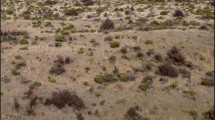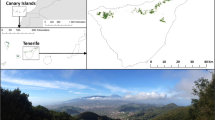Abstract
Phenological research in temperate-deciduous forests typically focuses on upper canopy trees, due to their overwhelming influence on ecosystem productivity and function. However, considering that shrubs leaf out earlier and remain green longer than trees, they play a pivotal role in ecosystem productivity, particularly at growing season extremes. Furthermore, an extended growing season of non-native shrubs provides a competitive advantage over natives. Here, we report spring phenology, budburst, leaf-out, and full-leaf unfolded (2017–2021) of a range of co-occurring species of tree (ash, American basswood, red oak, white oak, and boxelder) and shrub (native species: chokecherry, pagoda dogwood, nannyberry, American wild currant and Eastern wahoo, and non-native species: buckthorn, honeysuckle, European privet, and European highbush cranberry) in an urban woodland fragment in Wisconsin, USA, to determine how phenology differed between plant groups. Our findings show that all three spring phenophases of shrubs were 3 weeks earlier (p < 0.05) than trees. However, differences between shrubs groups were only significant for the later phenophase; full-leaf unfolded, which was 6 days earlier (p < 0.05) for native shrubs. The duration of the spring phenological season was 2 weeks longer (p < 0.05) for shrubs than trees. These preliminary findings demonstrate that native shrubs, at this site, start full-leaf development earlier than non-native species suggesting that species composition must be considered when generalizing whether phenologies differ between vegetation groups. A longer time series would be necessary to determine future implications on ecosystem phenology and productivity and how this might impact forests in the future, in terms of species composition, carbon sequestration, and overall ecosystem dynamics.




Similar content being viewed by others
Data Availability
All phenological data are in the process of being assessed for inclusion in the data repository PANGAEA (www.pangaea.de).
References
Beaubien E, Hamann A (2011) Spring flowering response to climate change between 1936 and 2006 in Alberta, Canada. Bioscience 61:514–524
Caffarra A, Donnelly A (2011) The ecological significance of phenology in four different tree species: effects of light and temperature on bud burst. Int J Biometerol 55(5):711–721
Chadde SW (2019) Wisconsin Flora: an illustrated guide to the vascular plants of Wisconsin. Orchard Innovations, USA
Chen HY, Matter SF (2017) Quantification of changes in light and temperature associated with invasive Amur honeysuckle (Lonicera maackii). Am Midl Nat 117(1):143–152
Donnelly A, Yu R (2021) Temperate deciduous shrub phenology: the overlooked forest layer. Int J Biometerol 65(3):343–355. https://doi.org/10.1007/s00484-019-01743-9
Donnelly A, Yu R, Rehberg C, Meyer G, Young EB (2020) Leaf chlorophyll estimates of temperate deciduous shrubs during autumn senescence using a SPAD-502 meter and calibration with extracted chlorophyll. Ann Forest Sci 77(2):1–12
Donnelly A, Yu R, Liu L, Desai AR, Hanes JM, Liang L, Schwartz MD, Caffarra A (2019) Comparing in-situ leaf observations in early spring with flux tower CO2 exchange and MODIS EVI in a northern mixed forest over a 5-year period. Agr Forest Meterol 278:107673
Donnelly A, Yu R, Caffarra A, Hanes JM, Liang L, Desai AR, Liu L, Schwartz MD (2017) Interspecific and interannual variation in the duration of spring phenophases in a northern mixed forest. Agr Forest Meterol 243:55–67
Donnelly A, Yu R (2017) The rise of phenology with climate change: an evaluation of IJB publications. Int J Biometerol 61(1):29–50
Ehrenfeld JG (2003) Effects of exotic plant invasions on soil nutrient cycling processes. Ecosystems 6:503–523
Fridley JD (2012) Extended leaf phenology and the autumn niche in deciduous forest invasions. Nature 485:359–364
Gill DS, Amthor JS, Bormann FH (1998) Leaf phenology, photosynthesis, and the persistence of saplings and shrubs in a mature northern hardwood forest. Tree Physiol 18(5):281–289
Harrington RA, Brown BJ, Reich PB (1989) Ecophysiology of exotic and native shrubs in Southern Wisconsin I Relationship of leaf characteristics, resource availability, and phenology to seasonal patterns of carbon gain. Oecologia 80:356–367
Huff S, Poudel K, Ritchie M, Temesgen H (2018) Quantifying aboveground biomass for common shrubs in northeastern California using nonlinear mixed effect models. Forest Ecol Manag 424:154–163
Jolly WM, Nemani R, Running SW (2004) Enhancement of understory productivity by asynchronous phenology with overstory competitors in a temperate deciduous forest. Tree Physiol 24(9):1069–1071
Kato S, Komiyama A (2002) Spatial and seasonal heterogeneity in understory light conditions caused by differential leaf flushing of deciduous overstory trees. Ecol Res 17(6):687–693
Klosterman S, Hufkens K, Richardson AD (2018) Later springs green-up faster: the relation between onset and completion of green-up in deciduous forests of North America. Int J Biometeorol 62:1645–1655
Knight KS, Kurylo JS, Endress AG, Stewart JR, Reich PB (2007) Ecology and ecosystem impacts of common buckthorn (Rhamnus cathartica). Biol Invasions 9:925–937
Maeno H, Hiura T (2000) The effect of leaf phenology of overstory trees on the reproductive success of an understory shrub Staphylea bumalda DC. Can J Bot 78:781–785
Maynard-Bean E, Kaye M, Wagner T, Burkhart EP (2020) Citizen scientists record novel leaf phenology of invasive shrubs in eastern US forests. Biol Invasions 22:3325–3337
Maynard-Bean E, Kaye M (2020) The seasonal influence of invasive shrubs on light and temperature in an Eastern deciduous forest understory. Nat Areas J 41(3):186–194
Menzel A, Sparks TH, Estrella N, Koch E, Aasa A, Ahas R, Alm-Kübler K, Bissolli P, Braslavská O, Briede A, Chmielewski FM, Crepinsek Z, Curnel Y, Dahl Å, Defila C, Donnelly A, Filella Y, Jatczak K, Måge F, Mestre A, Nordli Ø, Peñuelas J, Pirinen P, Remisová V, Scheifinger H, Striz M, Susnik A, Wielgolaski F-E, van Vliet A, Zach S, Zust A (2006) European phenological response to climate change matches the warming pattern. Global Change Biol 12:1–8
O’Connell E, Savage J (2020) Extended leaf phenology has limited benefits for invasive species growing at northern latitudes. Biol Invasions 22:2957–2974
Panchen ZA, Primack RB, Gallinat AS, Nordt B, Stevens AD, Du YJ, Fahey R (2015) Substantial variation in leaf senescence times among 1360 temperate woody plant species: implications for phenology and ecosystem processes. Ann Bot-London 116(6):865–873
Panchen ZA, Primack RB, Nordt B, Ellwood ER, Stevens AD, Renner SS, Willis CG, Fahey R, Whittemore A, Du YJ, Davis CC (2014) Leaf out times of temperate woody plants are related to phylogeny, deciduousness, growth habit and wood anatomy. New Phytol 203(4):1208–1219
Peñuelas J, Rutishauser T, Filella I (2009) Phenology feedbacks on climate change. Science 80(324):887–888
Pettorelli N, Pelletier F, von Hardenberg A, Festa-Bianchet M, Côté SD (2007) Early onset of vegetation growth vs rapid green-up: impacts on juvenile mountain ungulates. Ecology 88:381–390
Piao S, Friedlingstein P, Ciais P, Viovy N, Demarty J (2007) Growing season extension and its impact on terrestrial carbon cycle in the Northern Hemisphere over the past 2 decades. Glob Biogeochem Cycles 21 https://doi.org/10.1029/2006GB002888
Polgar C, Gallinat A, Primack RB (2014) Drivers of leaf-out phenology and their implications for species invasions: insights from Thoreau’s Concord. New Phytol 202(1):106–115
Polgar CA, Primack RB (2011) Leaf-out phenology of temperate woody plants: from trees to ecosystems. New Phytol 191:926–941
Richardson AD, O’Keefe J (2009) Phenological differences between understory and overstory. In: Noormets A (ed) Phenology of ecosystem processes. Springer, New York, pp 87–117
Rollinson CR, Kaye MW (2012) Experimental warming alters spring phenology of certain plant functional groups in an early successional forest community. Global Change Biol 18:1108–1116
Schuster MJ, Wragg PD, Reich PB (2021) Phenological niche overlap between invasive buckthorn (Rhamnus cathartica) and native woody species. For Ecol Manage 498:119568. https://doi.org/10.1016/j.foreco.2021.119568
Voss EG, Reznicek AA (2012) Field manual of Michigan flora. 305–306. University of Michigan Press, USA
Webster CR, Jenkins MA, Jose S (2006) Woody invaders and the challenges they pose to forest ecosystems in the Eastern United States. J for 104:366–374
Wolkovich EM, Cleland EE (2011) The phenology of plant invasions: a community ecology perspective. Front Ecol Environ 9(5):287–294
Yu R, Schwartz MD, Donnelly A, Liang L (2016) An observation-based progression modeling approach to spring and autumn deciduous tree phenology. Int J Biometeorol 60:335–349
Zohner CM, Renner SS (2019) Ongoing seasonally uneven climate warming leads to earlier autumn growth cessation in deciduous trees. Oecologia 189:549–561
Acknowledgements
This work was supported by a Research Growth Initiative grant (101x368) from the University of Wisconsin-Milwaukee. We are grateful to Gretchen Meyer (UWM Field Station director) for granting us access to Downer Woods and helping with species identification. We also thank two anonymous reviewers for their insightful comments.
Funding
University of Wisconsin-Milwaukee,101×368, Alison Donnelly.
Author information
Authors and Affiliations
Contributions
Alison Donnelly conceived and designed the research project, established the monitoring campaign, analyzed the data, and wrote the MS. Rong Yu helped with data analysis. Chloe Rehberg collected some of the data. Mark D. Schwartz provided some data.
Corresponding author
Ethics declarations
Competing interests
The authors declare no competing interests.
Supplementary Information
Below is the link to the electronic supplementary material.
Rights and permissions
Springer Nature or its licensor (e.g. a society or other partner) holds exclusive rights to this article under a publishing agreement with the author(s) or other rightsholder(s); author self-archiving of the accepted manuscript version of this article is solely governed by the terms of such publishing agreement and applicable law.
About this article
Cite this article
Donnelly, A., Yu, R., Rehberg, C. et al. Characterizing spring phenology in a temperate deciduous urban woodland fragment: trees and shrubs. Int J Biometeorol 68, 871–882 (2024). https://doi.org/10.1007/s00484-024-02632-6
Received:
Revised:
Accepted:
Published:
Issue Date:
DOI: https://doi.org/10.1007/s00484-024-02632-6




